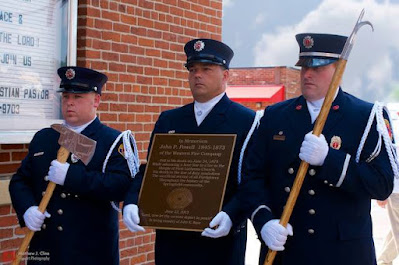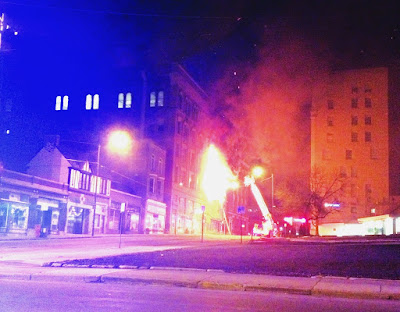Reports of the time remind us, however, of a sort of power that hasn’t changed in 140 years of firefighting: the power of the emotions that course through a community when a firefighter is killed on the job.
“Bravery and self-denying devotion to the public weal in an official, or public servant, never fail of being properly appreciated in this community,” said the June 27, 1873, Springfield News.
It did so to honor the sacrifice of 27-year-old John P. Powell, who fell to his death while fighting the fire in the spire that had been struck by lightning.
In their resolution honoring him, Powell’s fellow firefighters reflected on the timeless themes of mortality and their calling’s special vulnerability to it.
“By the death of our brother fireman … we are again warned of the uncertainty of life, and the perilous positions we occupy as fireman, and the hazardous risks and duties we are expected and called upon to perform, the danger to health and life and limb, which necessarily attends every call to action.”
“While faithfully discharging his duty,” the resolution added, Powell “was without a moment’s warning hurled into eternity by one fatal step in the wrong direction.”
The church’s Centennial History describes what happened.
A new chemical fire apparatus a salesman had brought to the city was rushed to the scene and “squelched the blaze about the lower part of the spire — an achievement which modern fire fighting equipment could hardly surpass,” the history reports. “But the upper portion of the steeple was still in flames."
Ladders were rigged by the firemen who were determined to carry their hose to the very top of the steeple, if necessary. But the hose leaked, and the higher the firemen climbed, the weaker were the streams from the nozzle.”
As the fire continued to rage, “hosemen of Queen Company carried a line of hose into the church, and up into the smoke-filled tower that supported the steeple. Into the steeple itself clambered John Powell, who carried the play pipe. Up he went, near and near to the flames, his comrades climbing after him and carrying the hose.
“Half-choked, half-blinded, the intrepid young Powell stepped to a board that lay on the cross braces of the tower. But he did not see that he was trusting himself to an unsupported end of the board, and in the next instant, he was hurtling downward to the floor 35 feet below.
“His neck was broken, and his comrades carried him across the street to the office of Dr. W.N. Hedges, where he died a few minutes later.”
Circumstances heaped sadness upon sorrow, as the newspaper story reported.
“The unfortunate young man was to have been married on the coming Fourth of July to a most worthy young lady of this city, who was present and the scene of death and whose lamentations were heart-rending.”
The members of the English Lutheran Church feared the pride they’d had in the tallest steeple in the city had contributed to Powell’s fall. Indeed, because the large Crowell-Collier printing facilities were yet to be built, the spire dominated the West High Street skyline.
In the Centennial History, George L. Rinkliff writes: “Had the tragic death … been prevented, the burning of the steeple would have been more of a benefit than a disaster. It was far better to have the congregation free of debt than to have some of its borrowed money invested in a wooden structure that reared 160 feet above the ground, inviting the wrath of the elements, and beyond the reach of the protective appliances of man.”
“In the congregation, it’s a turning point,” said William Kinnison, former Wittenberg University president and the church’s historian. “Everybody felt a little ashamed of themselves.”
As a result, “they started setting up missions and Sunday schools in other parts of town,” he said, concentrating on the more substantial business of church. The results included the founding of the Second through Fifth English Lutheran churches and others.
Nor was the steeple rebuilt for many years.
The church was not alone in feeling a sense of responsibility for Powell’s death.
At its next meeting, the city council tabled the offered resignation of disconsolate Fire Chief R.Q. [King], then unanimously passed a motion to purchase 1,000 feet of new rubber or leather hose to replace the leaking lengths.
After funeral services at his brother-in-law’s home on Columbia Street, Powell’s casket was placed on the sidewalk in front of the home so that people could pay their respects.
The funeral parade included Masons, Odd Fellows, Knights of Pythias, Fire Department and Molders — groups with which Powell had been affiliated. All marched toward Ferncliff Cemetery to dirges played by the American Coronet Band.
“The sidewalks were lined with spectators and a Sabbath-like quiet prevailed, broken only by the sad notes of the band,” the newspaper said. “It has been remarked that the funeral was probably the largest ever known here … The engine houses were closed and draped in mourning, and the bells tolled until the funeral procession had returned.”





